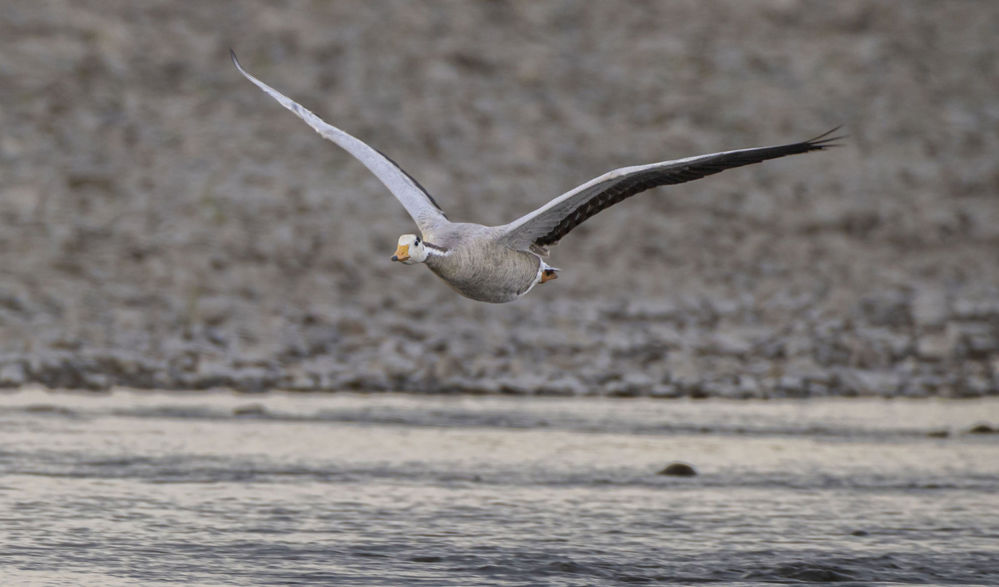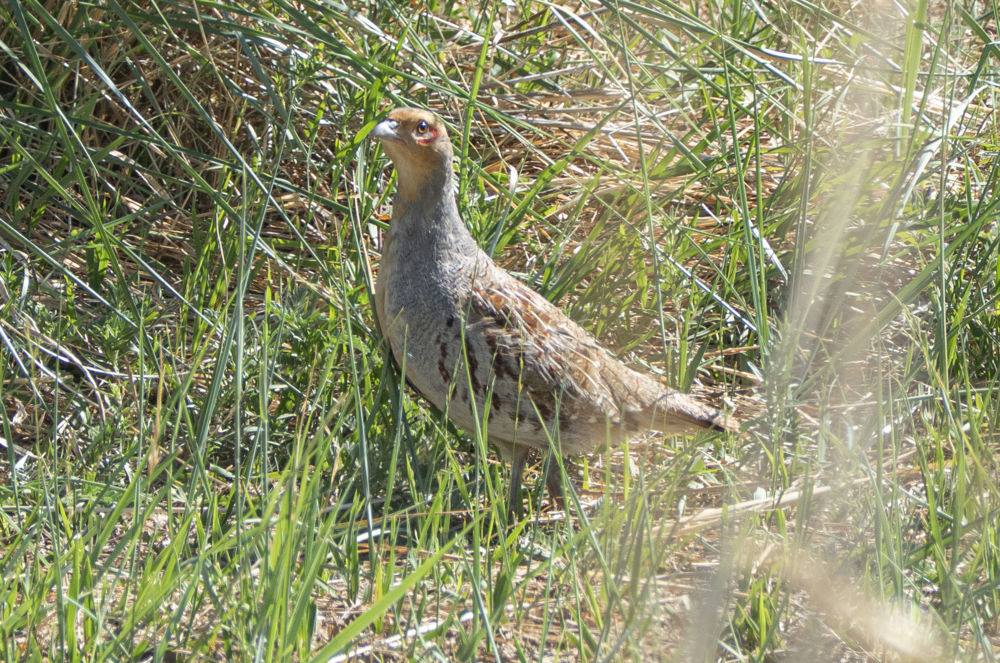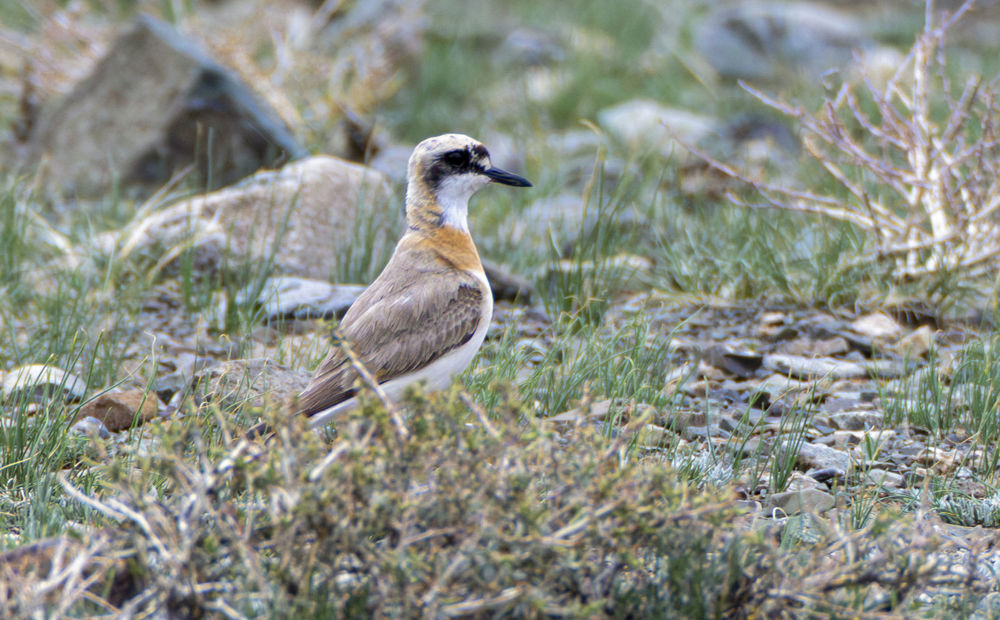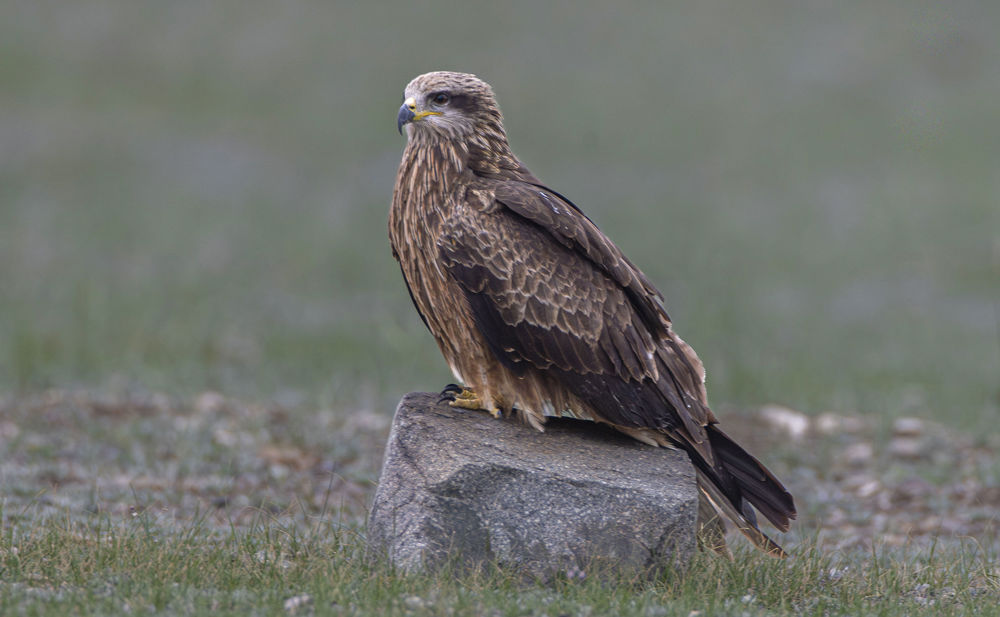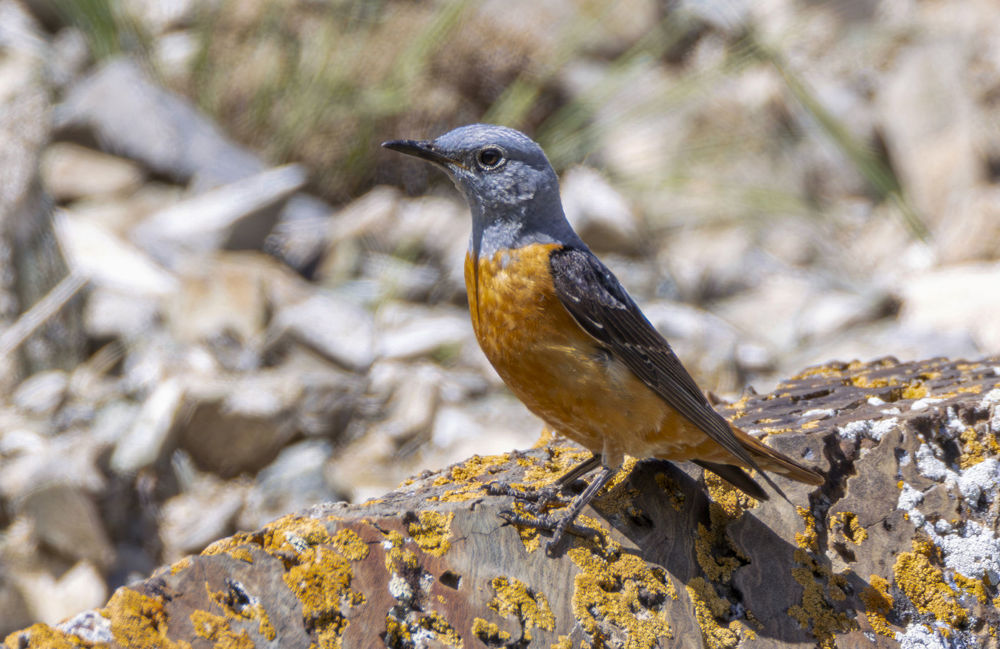Departure Date: June 22 - July 6, 2025
Compiled By: Rafael Galvez
Trip Leaders: Rafael Galvez, Local Leader
Toll Free: 800.328.8368
Phone: 512.328.5221
Snow Leopards of Mongolia 6/22/2025-7/6/2025

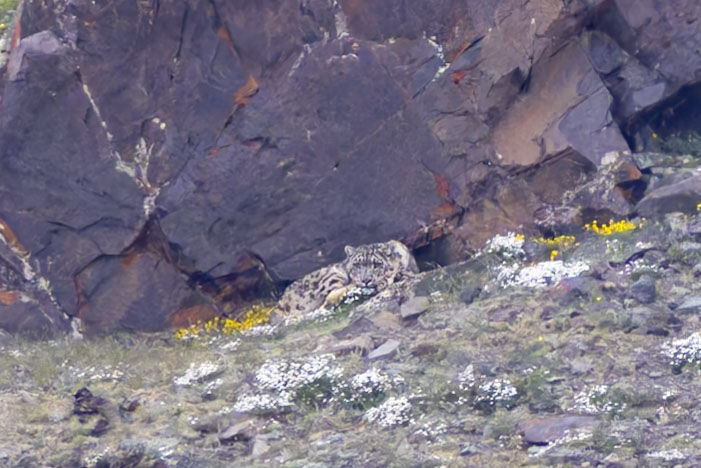
Snow Leopard by Rob Broeren
For the mere fact that few people ever travel to Mongolia, this tour was an incomparable adventure! The magnificent landscapes of the Altai and the diverse wildlife of the region are stunning. The colossal enormity of Mongolia was finally palpable once we arrived in the Khovd Region, unfurled in waves of mountain taiga and steppe below the cobalt immensity: “The Land of Eternal Blue Skies.”
Mongolia is shrouded in mystery, one of the least densely populated landmasses on the planet, and much unexplored. Ancient hordes rode freely across the uninterrupted expanse, bent on conquering the world, culminating in the rule of Chinggis Khan. It is an insular nation with a strong identity, developing at a pace quite different from what we often expect in the West. Cultural gaps are vast, and they aren’t as simple as language differences. To this day, the majority of Mongolians maintain a nomadic, pastoral lifestyle. During this tour, we had the opportunity to stay at traditional ger habitations, and to visit remote regions of the country few people ever travel to. Our experiences at ger camps were voted as one of the favorites of the tour!
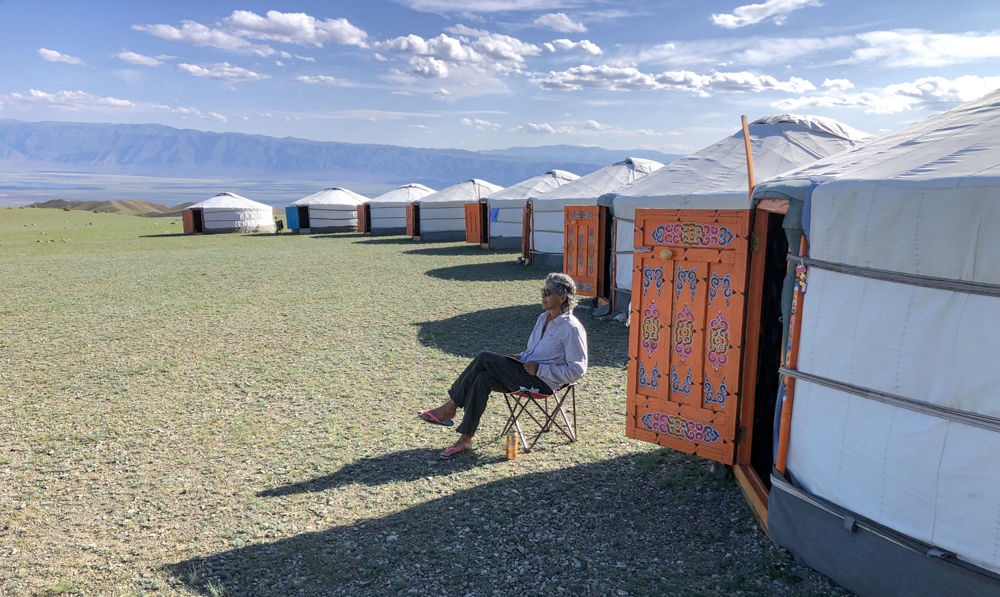
Ger Camp at Khovd by Rafael Galvez
We worked with Mongolian ground teams in two different regions, and they granted us safe passage to the best locations for wildlife, fed us, and delivered their trusted services to the best of their abilities. We all embarked on this adventure with open hearts and minds, ready for wonderful surprises and beautiful experiences.
Relatively few birders visit Mongolia, so we often turn up exciting surprises when we visit, and this time was no exception. As a result, we found 167 bird species and two dozen species of mammals. Highlights were many, but among the most memorable were all the young birds under parental care, including ducklings and cygnets, baby grebes, and most memorable, White-naped and Demoiselle cranes with their baby colts. Near-encounters with calling Black-billed Capercaillies and Gray Nightjar were enigmatic, while an assortment of reed-dwelling songbirds including Bearded Reedlings, Blyth’s Reed Warblers, and Paddyfield Warblers—among several others, made for a memorable morning along Khar Us Lake. The raptors also captured our attention and imagination, from the magnificent Lammergeier and Cinereous Vulture to the ubiquitous Steppe Eagle and Black-eared Kites; raptors were always nearby.
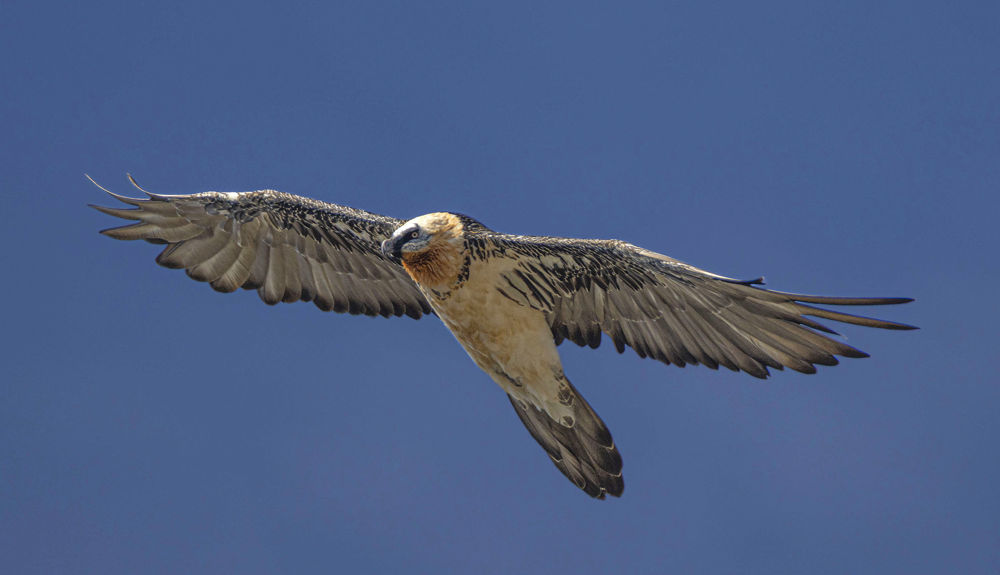
Lammergeier by Rob Broeren
Arrivals – Mongolica to Terelj and Gun Galuut
Our base throughout the tour was the Mongolica Hotel on the outskirts of Ulaanbaatar, to which we returned before and after our visit to western Mongolia. Additionally, Mongolica’s grounds offered birding opportunities, rendering a number of species we did not see elsewhere including Long-tailed Rosefinch, Azure Tit, White-cheeked Starling, and Lesser Spotted Woodpecker. This was also a great site for Pacific Swifts, various Corvids, waterfowl including Ruddy Shelduck, and even Siberian Ibex foraging along the adjacent cliffsides.
After all members of our group arrived on June 22, we all met after breakfast the next morning for an orientation prior to our departure. We arrived at the resort region of Terelj by midday, and after lunch we settled into our gers. We then visited the grounds of the Aryapala Temple in search of birds. As we explored the slopes near the entrance, we had the first of many encounters with singing Pine Buntings, and a surprising Gray Nightjar that called persistently. Upon returning to camp, some of us went birding along the adjacent forests and cliffs, finding Hume's and Arctic warblers, Greater Whitethroat, Daurian Redstart, and the first of many Rufous-tailed Rock-Thrushes.
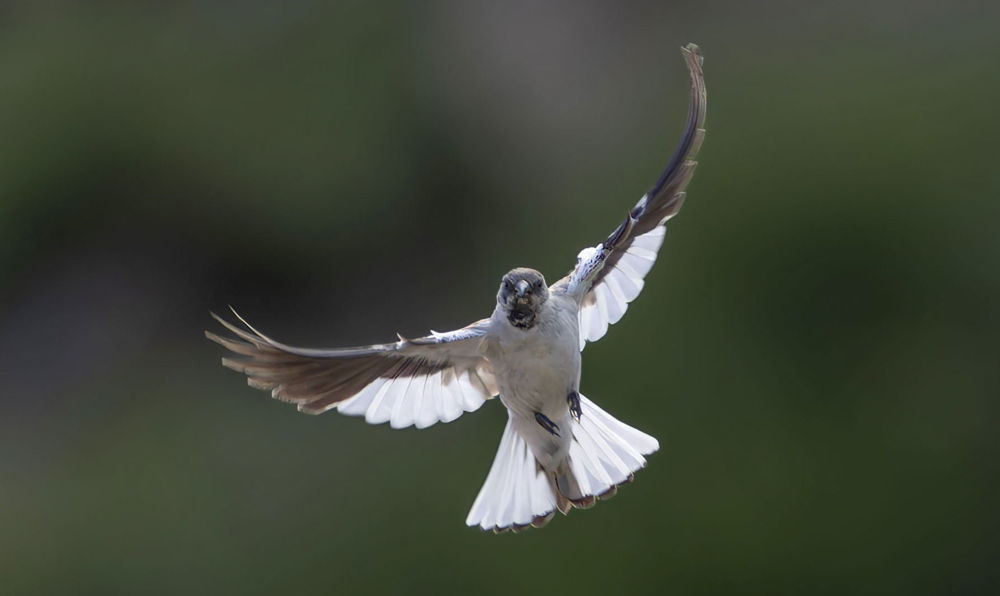
White-winged Snowfinch by Rob Broeren
The morning of June 24, we left towards forested realms, where we found singing Red-flanked Bluetails, Two-barred Warblers, and calling Black-billed Capercaillies! The forests also held Black Woodpecker, Taiga Flycatcher, and Tree Pipit. We then crossed vast uncharted terrain on our caravan of 4x4 vehicles, driving across undulating steppe corridors, getting our first glimpse at the immensity of Mongolia. We finally arrived at Gun Galuut by early afternoon.
At Gun Galuut, we settled into our comfortable chalets, and after a hearty lunch, we set out to explore the nature reserve. We spent two days there, exploring the slopes, lakes, and wetlands. We were all very excited to find Demoiselle and White-naped cranes taking care of young colts. Most parent pairs we saw had two chicks each. One very interesting moment was watching a pair of Demoiselles seeing our vehicle approaching at quite a distance, and leaving their two chicks at a hiding place, followed by exaggerated postures with hunched runs, meant to distract and move us away from their offspring. It was also very exciting to find a Siberian Crane, one of the rarest birds on the planet and critically endangered.
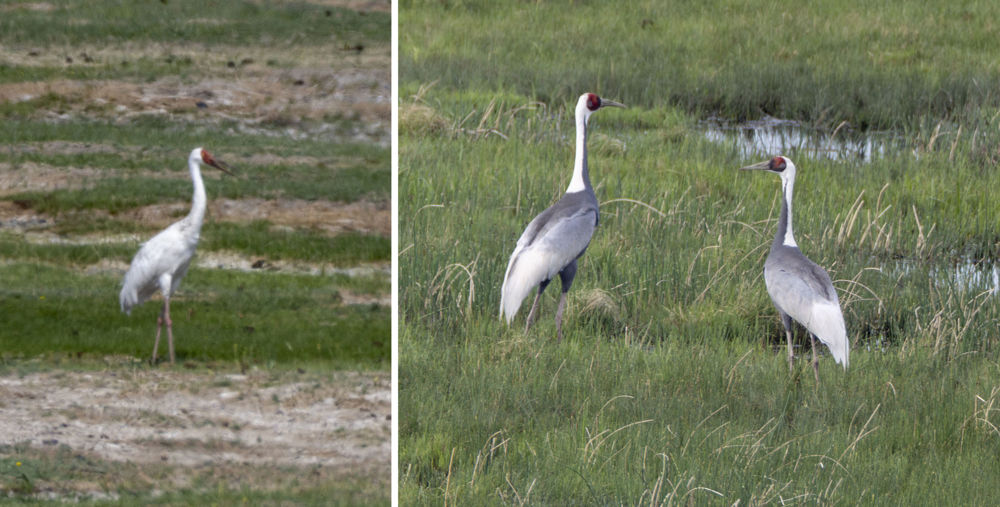
Left: The rare Siberian Crane. Right: White-naped Cranes. Photos by Rob Broeren
In the lakes we saw many wonderful species including several shorebirds such as Pied Avocet and Spotted Redshank, Eurasian Curlew, Green and Wood sandpipers, and more. Other waders included Black Stork, Eurasian Spoonbill, and Gray Heron. Waterfowl included Whooper Swan, Bar-headed Goose, Ruddy and Common shelducks, Eastern Spot-billed Duck, Red-crested and Common pochards, Common Goldeneye, and many more. Mongolian Larks were common in the area, with Asian Short-toed and Horned larks in the mix, while Citrine Wagtails added flashes of color.
On our final afternoon at Gun Galuut we set out for slopes where we quickly found groups of Argali along the cliffs. At nearby wetlands, Black-tailed Godwits displayed, while waterfowl of various species tended to their young. A pair of male and female Eastern Marsh Harriers was observed cooperating in flight, as they harassed a standing White-naped Crane time and again. It did not take long to reveal that its mate was lying down nearby, sheltering two young colts from the attacks by the harriers!
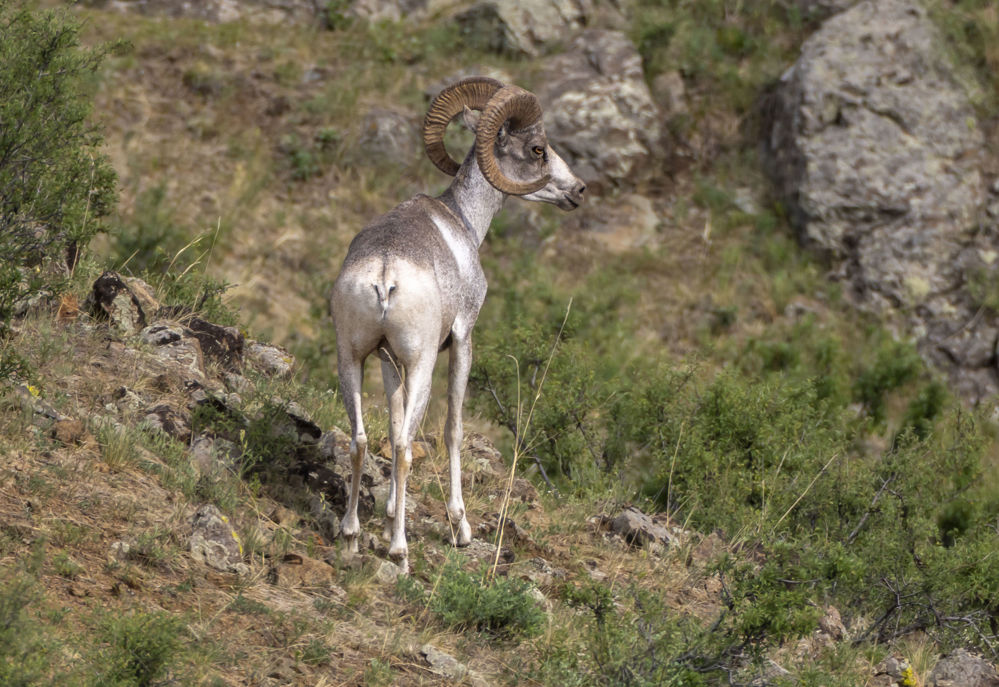
Argali by Rob Broeren
Khovd
After a morning in Gun Galuut, we were back at the Mongolica Hotel for the night of June 26. The following morning, we embarked on an early flight from the Chinggis Khan Airport to the town on Khovd in far-flung northwest Mongolia. We arrived late morning and were informed right away that a Snow Leopard was being seen up at the summit of Jargalant Mountain. With our luggage in our 4x4 vehicles, we did not waste time stopping by the ger camp to settle in and get organized. A Snow Leopard sighting needs to be taken with utmost seriousness, for you never know when another may be spotted again. We crossed the steppe through unpaved roads and then started the arduous climb up steep slopes, as our drivers expertly maneuvered the vehicles up ravines and winding ledges until we were high up above 10,000 feet. The team of local scouts had indeed secured their sights on a Snow Leopard resting alongside an outcrop across the gorge, eye level with us. It was near-impossible to see it with bare eyes, for the cat blended in perfectly with the porous rock surface of the mountain cliffs, and due to distance. Even through the scope, when the view was perfectly centered on the leopard, its stillness and perfect camouflage betrayed the viewer, and one had to patiently acclimate to what was in view, until the outline of the feline finally became clear. We spent hours observing the enigmatic Snow Leopard and were greatly satisfied. All the while, birds were also found in the area, including Lammergeier, Cinereous Vulture, White-winged Snowfinch, Guldenstadt’s (White-winged) Redstart, and other alpine species.
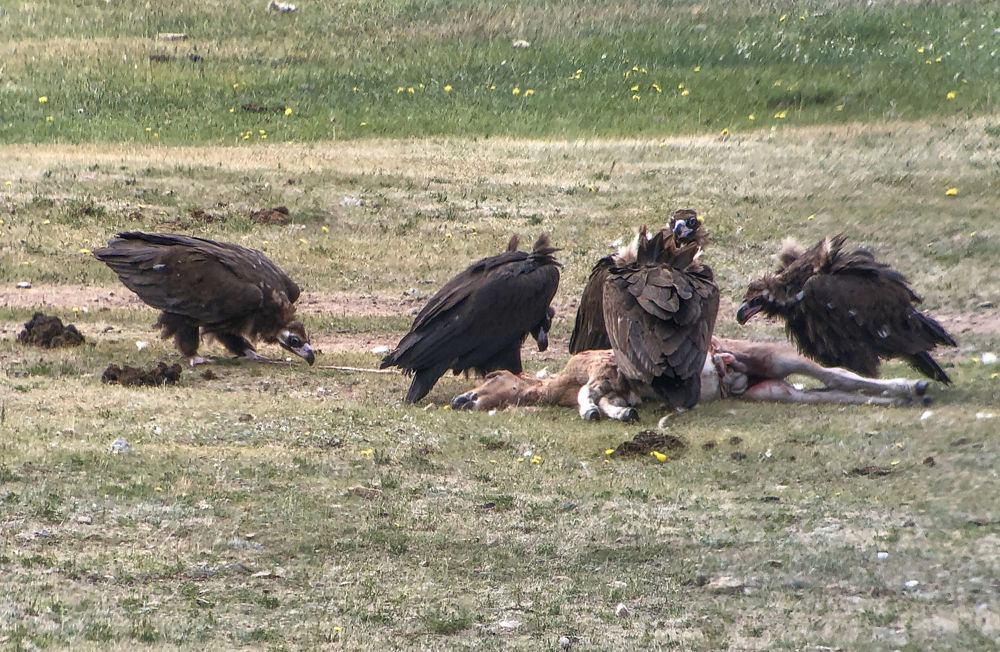
Cinereous Vultures by Rafael Galvez
We spent six days in Khovd, during which we visited various lakes, explored enormous plains, and birded through verdant ravines. We found Siberian Ibex, Goitered Gazelle, and had close encounters with the endangered Saiga, an enigmatic antelope with an unusually flexible snout. Typically, we see half a dozen Saiga at a distance, running away with their distinctive lowered head profile. This time, we found many more Saiga, some of them quite approachable! Other highlights included Brown Accentor, Black Redstart, and Rufous-tailed Rock-Thrushes; wheatears of four species including Desert and Pied; Pallas’s Sandgrouse; and Siberian and Greater sand-plovers. Gulls and terns included Pallas’s and Mongolian gulls, and Little, Caspian, and White-winged terns. While Great Crested Grebes were common close to shore, we also managed to find Arctic Loons in deeper waters. As we made a final exploration of gorges up Jargalant and near Bumbat, we found Mongolian Finches, Water Pipits, coveys of Chukars, and heard Altai Snowcocks several times. At the Valley of Dead Ibex, we had our best encounters with Siberian Ibex and Lammergeiers, along with Greenish and Barred warblers and Gray-necked Bunting. Among the most memorable and challenging encounters were those with the elusive and charismatic Mongolian Ground-Jay. We finished our time in Khovd with a wonderful program of traditional Khoomei throat singers from the town of Khovd, accompanied by instrumentation and a young dancer.
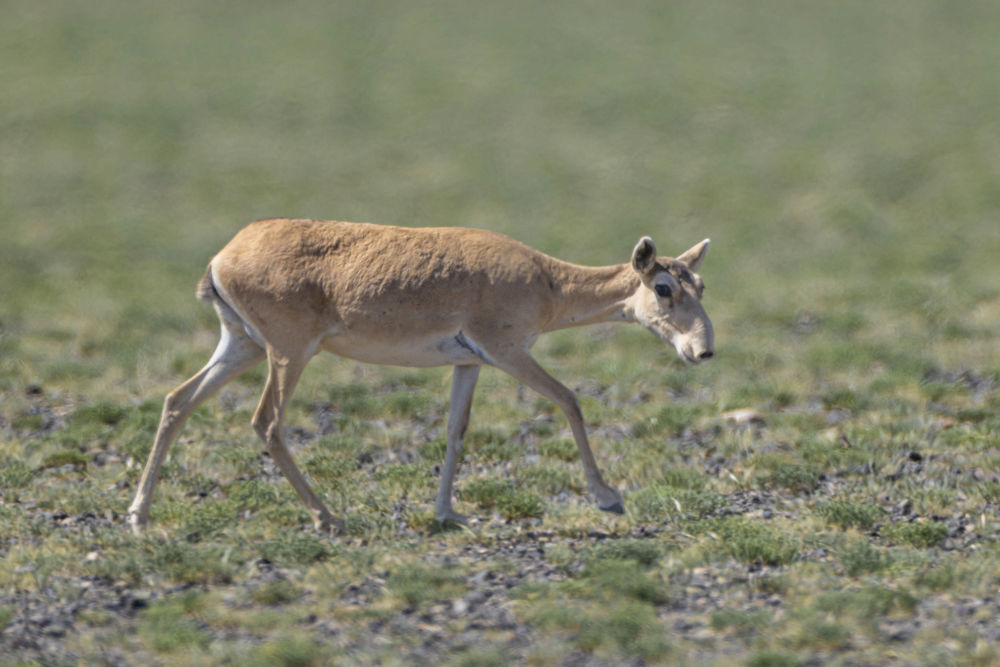
Saiga by Rob Broeren
Hustai
On July 3, our flight out of Khovd from the settlement of Altai got us back to the Mongolica Hotel late that night. Without a rush, we left the next morning towards Hustai National Park. Along the way, we found a recently plowed field with 45 Steppe Eagles resting on it—a magnificent event! After a good lunch and some rest, we went out that afternoon into the wavering steppe of the park and found the mythical Przewalski’s Horse in herds up along the hillsides, and Wapiti (Siberian Elk) on the ridges. Targaban Marmots were more common at Hustai than they had been in Khovd. After some searching, we finally found Mongolian Gazelles—mostly females with one or two young. We also came upon a surprising event, during which wolves were briefly observed trailing gazelles in chase. This foreshadowed the events of the following morning. With the assistance of the primary park ranger at Hustai during our final morning of the tour, we set out before daybreak deeper into the park in search of the elusive Gray Wolf. First, we heard howling in the distance, still under pitch darkness. Three Wapiti with tremendous racks were silhouetted against the sky’s first glow. We then inched up a rocky incline and scanned the surrounding hills until we found two wolves—and admired them at length. On the way out we found Daurian Partridges, which proved to be the last new birds of the tour.
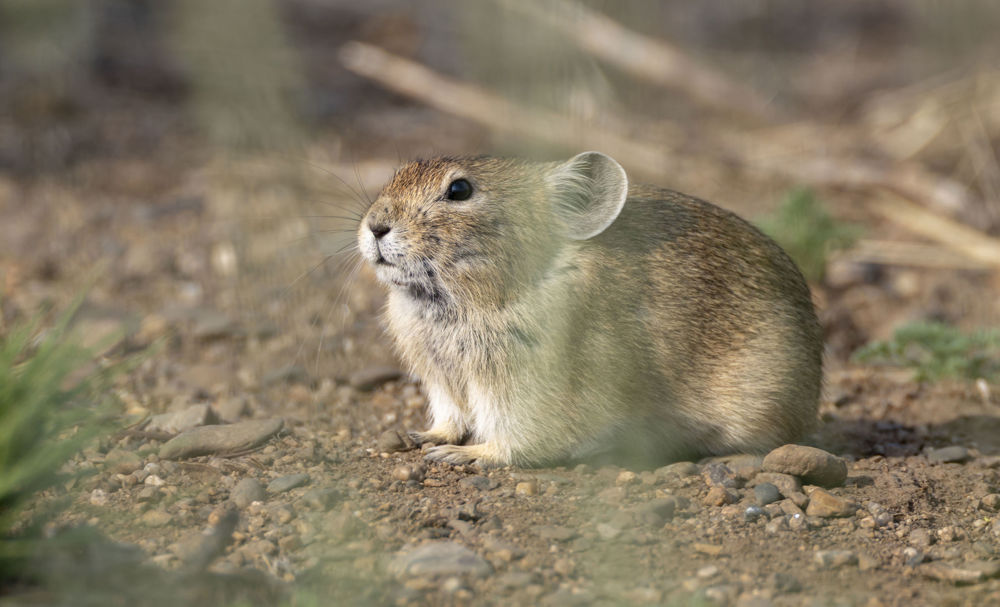
Daurian Pika by Rob Broeren
We enjoyed our final dinner on the evening of July 5. We were a merry and diverse group, each having hopefully achieved a personal goal during this unique tour—for some finally seeing all of the world’s crane species, for others seeing a Saiga, gazelles and other mammals—including the legendary Snow Leopard, while for most it was the opportunity to traverse a country seldom visited, “The Land of Eternal Blue Skies.”
Favorite Experiences Voted by Tour Participants:
- The Cranes: Unanimously voted by everyone in some capacity was our experience with four species of cranes in Mongolia. The Demoiselle Cranes and their chicks were voted often, as were the White-naped Crane chicks, and our great views of Common and especially Siberian cranes.
- Wolves and Land: The wolves were voted for the excitement of the search for them during our final morning at Gun Galuut, escorted by the impressive game warden and anti-poacher at the park. The elusive moment when some of us saw wolves chasing gazelles the prior afternoon was also mentioned. The landscape captivated us, including the grand mountains and variety of habitats, the steppe filled with flowers and the scent of sage, and the diversity found in unusual locations such as the Valley of Dead Ibex.
- Snow Leopard, Przewalski’s Horse, and the Ger Experience: Our Snow Leopard experience in Jargalant Mountain was memorable, whether seeing the actual leopard, or climbing up the Altai mountains and being in its alpine realm. The Przewalski’s Horse was beautiful to see in the rolling hills of Hustai—a perfect setting. The Ger Experience got many votes, for how interesting it was to live in a round and portable habitation, for its durability and history, and for its ornamentations.
- Lammergeier, Siberian Ibex, Throat Singing, and our Group: The Lammergeier flew past us several times, and we even managed to see one perched! The Siberian Ibex were fun to see, particularly those that looked down on us with curiosity from cliff ledges. The Throat Singers who visited us were exceptional and gave us a cultural program you could not experience anywhere else in the world. Many mentioned how wonderful our group was, participants, guides, and interpreters.
- Cinereous Vulture and Raptors: The regal Cinereous Vulture was one of the most common raptors, at times resting close by with its feathered shawl waving in the breeze, or flying quite low. Several other raptors were also mentioned, particularly the Steppe Eagle, of which we saw many, and also the Himalayan Griffon, Upland Buzzard, and Amur Falcon.
- Sixth place was a tie: Mongolian Ground-Jay (and Marti running to see one), White-winged Snowfinch, Chukar (and chicks), Azure Tit, Saiga, Tarbagan Marmot, the Ovoo Shrines, and the domestic Bactrian Camels and Yaks.
- Honorable mentions included Desert Wheatear, Daurian Partridge, Altai Snowcock, Black-billed Capercaillie, Pallas’s Sandgrouse, Argali, Corsac Fox, Daurian Pika, the young traditional dancer, and others.
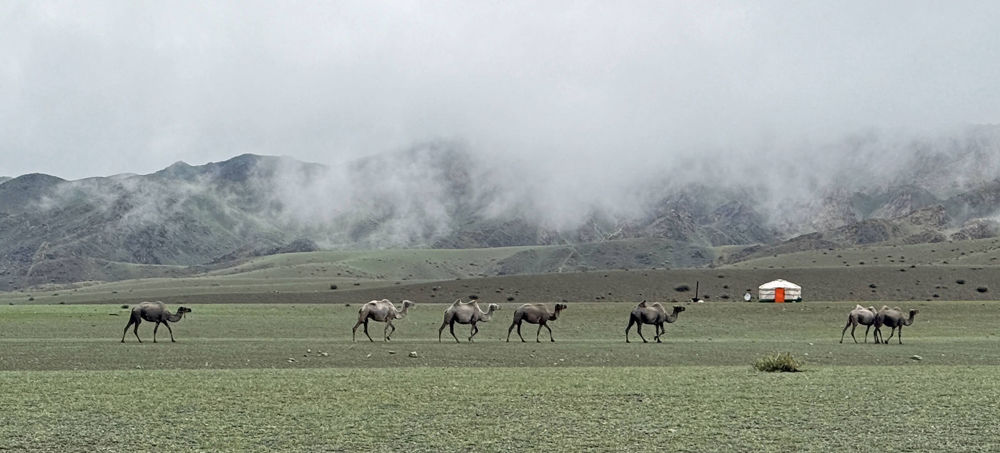
Bactrian Camels by Mike Boss
A complete list of the birds recorded on our tour can be found at: https://ebird.org/tripreport/397170
Read the description for the next departure of this tour.
View Rafael Galvez's upcoming tour schedule.
ITINERARY
June 22, 2025 – Arrivals. All members of our group arrived at the Chinggis Khan International Airport in Ulaanbaatar and were transferred to the Mongolica Hotel outside the capital.
June 23 – We all had breakfast at the Mongolica Hotel and met for an orientation. We departed towards Terelj by midmorning, arriving at noon, where we had lunch and settled into our gers. In the afternoon, we visited the Aryapala Temple grounds, where we birded for a couple of hours. Dinner and the night spent at Terelj Lodge.
June 24 – We left Terelj early and made a couple of stops at forests near Erdene, where we spent the morning birding. We then drove through the steppe, arriving at the Steppe Nomads Camp in Gun Galuut in the early afternoon. That afternoon, we went birding within the protected area. We spent the night at Gun Galuut.
June 25 – We spent the entire day birding within Gun Galuut, including the lakes, foothills, and wetlands of the natural reserve.
June 26 – After our final morning exploring the river and lakes at Gun Galuut, we began our return towards the capital. We stopped briefly at the enormous Chinggis Khan statue and arrived at the Mongolica Hotel by afternoon. We spent the night at the Mongolica Hotel.
June 27 – We left early morning towards the airport for a domestic flight to the western Mongolia region of Khovd. Once in the settlement of Khovd, we stopped for birding at a plantation. We soon learned that a Snow Leopard had been found up in the mountains, so we set out across the steppe, with lunch on the go. We continued climbing up the slopes of Jargalant, reaching 10,000 ft. asl. The Snow Leopard was waiting for us, resting alongside boulders on a cliff’s edge, and we all got lengthy views of the mysterious feline. Afterwards, we arrived at our ger camp and settled in for the night.
June 28 and 29 – During both of these days, we explored lakes and wetlands in the Khovd region, having pleasant picnic lunches outdoors, prepared by our Mongolian crew. We dedicated June 29 to exploring the enormous Khar Us Lake, finding many birds along its vast shorelines.
June 30 – We returned to Jargalant Mountain this day, taking our time to make several stops for birds as we climbed up the ravines towards the summit. Once at the top, we looked for high-altitude species. We spent another night at the ger camp in Khovd.
July 1 – We set out this morning towards Durgun Lake, a vast saltwater lake bordering the Gobi Desert. We traversed extensive flat plains where we found Saiga. By the reeds along the shoreline we found many bird species. We returned to the camp in the afternoon and settled in for the night.
July 2 – After some time spent in Jargalant, we visited the Valley of Dead Ibex, near Bumbat. Along the narrow valleys surrounded by cliff walls, we found many new birds, Siberian Ibex, and a perched Lammergeier. We were back at the camp by late afternoon, and after dinner, enjoyed a performance of traditional Khoomei throat singing by two expert musicians from Khovd. We spent our final night in Khovd at the ger camp.
July 3 – We left the camp, driving across vast stretches of open road towards Altai City for a flight that evening. We arrived in the afternoon for an early dinner, after which we headed to the airport. We spent the night back at the Mongolica Hotel.
July 4 – After plenty of rest, we left late that morning towards Hustai National Park. We made a few stops for birds before settling in at the park’s ger camp, and for some lunch. That afternoon, we explored the rolling hills of the park, finding Przewalski’s Horses, Wapiti, and Mongolian Gazelles. That night was spent at the ger camp at Hustai.
July 5 – We set out to explore Hustai before breakfast for a successful search for Gray Wolves. After lunch, we returned towards Mongolica Hotel for some final birding along the grounds of the hotel. We had our final dinner that night and said our goodbyes.
July 6 – Most participants were transferred throughout the day to the airport for departures, although a couple of members of our group left on July 7.
The following order of the field list and nomenclature are those given by eBird/Clements Checklist of Birds of the World: v2024. Underlined species indicate taxa of rare or very uncommon occurrence, or species that occur in such low densities as to be easily missed.

Demoiselle Cranes and Eurasian Spoonbills by Mike Boss

